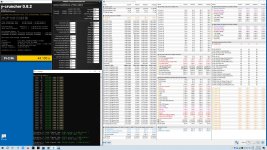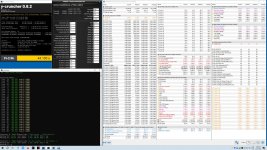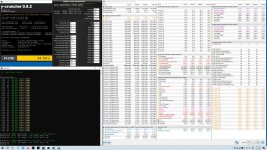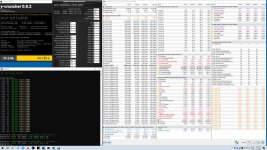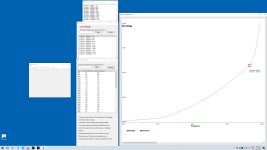zebra_hun
Profi
Ok, I'm also interested in how it works for you.Thanks! I will copy your values to run Y-Chruncher. There was a debate in OCN that it should always be run unlimited, for short tests it can work (4 cycles), but for tests of 90 minutes or 6 hours, without a doubt your configuration is the best. I'm going to see if it generates any WHEA for me
You are in luck with the SP105. Why is this good? I already recognized it, I tested the minimum values for my cpu for a couple of frequencies. For me, the minimum Vcore (Vmin) for the 54x Y Cruncher is 1.09V. Less is enough for you, so it's cooler. It is the same on the default 57x. For example, even with 8C water, the default, throttled, is 100C immediately. This is SP93.
Default Settings
Regarding degradation, all I know is that after more than 6-700 hours of Y, the 57x Vmin has not changed at all. When I bought it, Vmin was 1.18V, currently it is still 1.18V on Vmin Cinebench.
As new - not delided yet
Now - delided
I don't want to persuade, convince, etc., I use it this way, I test it so.
For example, I don't write a single letter on ocn. I don't want a conflict with anyone. I'm not on the DDR5 forum, but I read it sometimes. In DDR4, when I posted the 90-minute Y test, I was the stupidest person in the world.
I don't think anyone has that many Y Cruncher kilometers in their cpu, but there is no degradation. Well, that's enough about this topic.
A positive offset from 1600 helps. Don't have a lower Vcore, always raise it.Well, what I did was Load Optimized values, set LLC4 and read the value of AC_LL in the OCTool. Since it gave me 0.2689, before, I had tried lowering it, but it had instabilities. Precisely, what I wanted to do is a UV with the curve. I just saw yours and it is very different, because it starts higher up. I don't know how the CPU behaves at frequencies up to P4.
These minimum values must be experienced and known.
AUTO=8.Can I ask you why you set Ring mim so low? I just left all in auto..
Idle 800MHz. Core Clock is now 1100MHz, because Speed Shift is on. Off = CC 800MHz too.
I like it better if there is value than the auto. It doesn't matter.
SFT is the 99.99% good Vcore. SFT stable, it means a little more Vcore for me, so I'm writing quietly, I took a little off it.There I do want to put the entire load of YC testing. To test the CPU, SFT is better, right?
I like to set the machine to optimal, not to extreme oc. It's also good, fun, but not 24/7.
I see on forums that 6.2GHz allcore daily, but I ask myself, why? Its added value is 99% unnecessary, because almost everyone plays in 4k, with a total gpu limit. The extra 10-20 fps on the cpu side is pointless if the gpu can't handle it.
Well, yes, that's another topic. I'm not against oc, I just don't do oc unnecessarily. If I see the advantage of 57 or 60x, I will set it there.
These lines were my own thoughts, don't be fooled. As I started this post, this is how I do it. I like it when the cpu is cool, performs easily and works, rather than dying at 100C.


